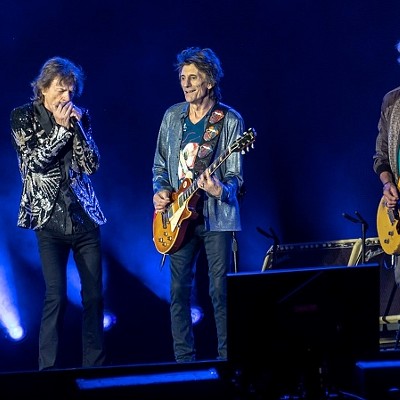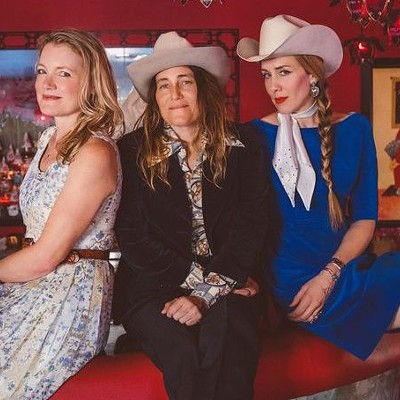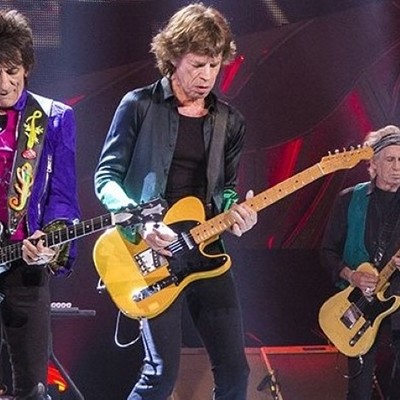Adam P. Newton recently became a father for the first time, so he has decided to explain the entirety of post-WWII Western pop music to his new daughter, "Fig"...one genre at a time.
Onward through the fog, Fig! And by “fog,” I mean how deliciously clustered much of the music from the ‘50s and ‘60s appears now in our popular consciousness. I had some difficulty splitting up the rock, soul, R&B and pop from these two decades into a few different posts, simply because we now associate most of these acts under the common moniker of “oldies.” To be clear, I don’t use that term as a pejorative. It’s important to understand how remarkably influential these sounds have been upon the last 50-plus years of music. As opposed to the racial barriers of the era that placed limits upon who did and who didn’t hear a given track, we now can experience this music as a unified whole and appreciate it fully.
Moreover, while exploring the most influential artists, record labels, and producers of this time period, I realized how similar it appears to music of this decade - at least in spirit. Whether you’re creating genres from scratch or tearing down the walls between them because you have ubiquitous access to music throughout recorded history, it seems the only thing that matters is just making the music you like and letting your creativity out to play. Besides, it’s always been the suits who have bothered about style and where things fit in terms of radio play and record sales.
On this list, we’re going to talk about the various artists who fall under the rubric of “pop music.” We’ll talk about a few crooners, compare pop to the burgeoning rock scene, discuss how people loved groups who harmonized, and wonder why so many people sing about love (and how often they lose it). We’ll also ignore one-hit wonders, no matter how memorable or influential, like “Earth Angel” by the Penguins. We’ll also avoid the tired game of trying to figure out which contemporary artist stole the most from any of the artists on this list, because that could get ugly quickly.
PATTI PAGE
One of the better-selling pop singers of all time, Page made her mark throughout ‘50s blending pop and country sensibilities into a coherent whole. Born Clara Ann Fowler, you could think of her as the flipside to Patsy Cline (who brought country into pop music). Her strong alto was warm, tender, and down-to-earth, whether it’s on a kitschy single like “How Much is That Doggie in the Window?” or a slow-burning romantic tune like “Allegheny Moon.” But I chose “The Tennessee Waltz” mostly because it was one of your maternal great-grandmother’s favorite songs, and because it showcases the clarity and purity of Page’s voice atop a loping 3/4 arrangement and gracious string-based instrumentation.
CONNIE FRANCIS
What I like most about the aesthetic of Connie Francis is her adventurous approach to pushing the boundaries of pop music in the late ‘50s and early ‘60s. After breaking big in 1957 with her cover of “Who’s Sorry Now?” she matched nearly every ballad translating an old song with a new track aimed specifically at her peers falling in love with rock music. Take “Stupid Cupid,” for instance — she updates her strong alto with a playful yodel and lyrics about young love before paring it with rockabilly guitar, handclaps and a great drum rhythm perfect for kids on the dance floor.
FRANK SINATRA
Known as “Ol’ Blue Eyes” (among other things), Sinatra was veritable Hollywood and Las Vegas royalty. Not only was he one of the top-selling singers of all time, the guy won an Academy Award in 1953. As with many jazz crooners who started their careers in this era, many of his well-known songs were often reinterpretations of songs from earlier in the century — think “I’ve Got the World on a String,” “I’ll Be Seeing You” and “The Way You Look Tonight.” But Sinatra also scored plenty of hits written exclusively for him, like “My Way.” “Come Fly with Me” is one of my favorites: It updates the big band and swing of the ’40s for a new decade by putting the voice front and center and layering pop formatting upon jazz chord progressions. And the guy could flat-out sing.
BOBBY DARIN
One of the few members of this group to pass away too early, Darin got his start writing songs for the aforementioned Connie Francis. But when he started penning his own tunes, he was a breakout teen star with “Splish Splash,” “Mack the Knife” and more. The song I most associate with Darin’s role in ‘50s pop music is “Dream Lover” — a clever ditty that married crooner-style vocals (and lyrics) with rippling drums, memorable guitar phrasing in the form of arpeggiated picked chords, and angelic background vocals.
DEAN MARTIN
Even though the two guys were close pals in “The Rat Pack,” I always feel like people liked Dean Martin more than Frank Sinatra as a person. Sinatra was more talented and successful, but you wanted to hang out with Martin. His comedic sensibilities shone through on and off the stage, even when he was crooning ballads like “Everybody Loves Somebody” and “That's Amore.” I much prefer tracks like “Ain’t That a Kick in the Head” — sure, it’s a love song, but it’s about love as a concept (instead of being directed to a lover), and it features some fantastic metaphors, bright horns, swinging rhythm and a very traditional verse-chorus-bridge-chorus format.
THE SHIRELLES
It wasn’t the first time a few friends started making music together, only to change music history for the better, but The Shirelles were a rather influential act. These four ladies basically created the concept of the “girl group” by merging doo-wop (primarily a male-dominated sound) with gospel harmonies and heaps of not-so-thinly-veiled sexual lyrics. I could have mentioned “Dedicated to the One I Love” or “Tonight’s the Night,” but I chose “Will You Still Love Me Tomorrow?” because it best encapsulates what I love about this overall sound. The arrangement and instrumentation are simple and direct, but the breadth of emotion conveyed by Shirley Owens lends a rich and unforgettable depth to this tune.
CHUBBY CHECKER
Checker could almost be called a one-hit wonder, but when you have multiple songs that launch multiple different dance crazes in the early ‘60s, it’s hard to ignore your impact. His voice falls firmly in the burgeoning soul and R&B camp, but his campy song material keeps him firmly planted in pop. And sure, I probably should have picked “The Twist” — which truly launched him to fame, but I’ve always felt “Let’s Twist Again” was a better tune. It has a stronger beat and more of a rock feel to the arrangement, and Checker delivers a better vocal performance. It’s simply more fun in my book, and that’s what you want from a good dance craze, right?
FRANKIE VALLI AND THE FOUR SEASONS
Your Meme and Granddaddy love this group, who were a rather infectious and influential bunch of harmonizers. The tuxedos in this video belie the youthful energy and vitality these four “Jersey Boys” evinced throughout their careers. From the outset, the falsetto lead vocals of Frankie Valli set this outfit apart from their lesser counterparts, but this was also a sharp pop group whose members played their own instruments while knocking four-part harmonies out of the park. With “Big Girls Don’t Cry,” Valli laments the loss of a girlfriend because of his own duplicitous behavior, and he doesn’t get any sympathy from the people in his life — all backed by a swinging pop chord progression and bright drumming.
THE CRYSTALS
It could be difficult to discuss The Crystals from the next entry on our list because of the shared influence that was Phil Spector and his “Wall of Sound” (not to mention his machinations as a studio executive). But with The Crystals, there was always a bit more verve to their sound, and you can specifically hear the influence in how Motown, Chess and Stax modeled its pop hits. And while we could have easily discussed the doo-wop of “Da Do Ron Ron” or the cinematic qualities of “Then He Kissed Me,” I prefer the rock-and-roll feel of “He’s a Rebel” — complete with the plinking piano melody, big baritone sax solo, strong drumming and swaggering vocal delivery.
THE RONETTES
From the outset, Ronnie Spector’s voice was so show-stopping in its sonic purity and sincerity. Joined by her older sister and cousin on background vocals, The Ronettes nearly took over the early ‘60s, as lovelorn tracks like “Walking in the Rain” and “Baby, I Love You” dominated radios and teenage hearts. But I selected “Be My Baby” from 1963 for a couple of reasons: The syncopated calypso percussion is so iconic now, and the vocals pierce right through the instrumental mix and get stuck right in your heart. Such a devastating tune.
THE RIGHTEOUS BROTHERS
I’ll be the first to admit that I could have discussed “blue-eyed soul” in next week’s installment, but I ultimately felt it fits in better with this week, especially in light of the crooners who appeared earlier. While they're not actually brothers, Bobby Hatfield’s tenor and Bill Medley’s baritone harmonized as effortlessly as any sibling group could. They possessed an earnest sentimentality with cuts like “Unchained Melody” and “Just Once in My Life,” but we’re here to talk about “You’ve Lost That Loving Feeling.” As with many of the songs on this list, the duo regrets falling out of love and wonders what could be done to reverse this loss, and it’s supported by a delightful chord progression that marries blues, jazz and pop music to delirious effect.
THE SHANGRI-LA'S
What set these Queens, New York, ladies apart from their girl-group counterparts was their tougher image and less naive lyrics. Peaking in popularity between 1964 and 1966, their influence skipped a musical generation to affect the development of punk and New Wave. They also pioneered the concept of the “death disc” — songs about young love that ended in tragedy — and “Leader of the Pack” is a key example of such a tune. The quintessential bad boy is the focus of the lyrics. but the singer is undeterred from her young love by popular opinion, all while screeching motorcycle sound effects punch up a warbling, tremolo-laden guitar and associated surf-rock instrumentation.
Next: Motown & the rise of '60s soul.
Support Us
Houston's independent source of
local news and culture
account
- Welcome,
Insider - Login
- My Account
- My Newsletters
- Contribute
- Contact Us
- Sign out
[
{
"name": "Related Stories / Support Us Combo",
"component": "11591218",
"insertPoint": "4",
"requiredCountToDisplay": "4"
},{
"name": "Air - Billboard - Inline Content",
"component": "11591214",
"insertPoint": "2/3",
"requiredCountToDisplay": "7"
},{
"name": "R1 - Beta - Mobile Only",
"component": "12287027",
"insertPoint": "8",
"requiredCountToDisplay": "8"
},{
"name": "Air - MediumRectangle - Inline Content - Mobile Display Size 2",
"component": "11591215",
"insertPoint": "12",
"requiredCountToDisplay": "12"
},{
"name": "Air - MediumRectangle - Inline Content - Mobile Display Size 2",
"component": "11591215",
"insertPoint": "4th",
"startingPoint": "16",
"requiredCountToDisplay": "12"
}
,{
"name": "RevContent - In Article",
"component": "12527128",
"insertPoint": "3/5",
"requiredCountToDisplay": "5"
}
]
KEEP THE HOUSTON PRESS FREE...
Since we started the Houston Press, it has been defined as the free, independent voice of Houston, and we'd like to keep it that way. With local media under siege, it's more important than ever for us to rally support behind funding our local journalism. You can help by participating in our "I Support" program, allowing us to keep offering readers access to our incisive coverage of local news, food and culture with no paywalls.
Adam P. Newton
Contact:
Adam P. Newton
Trending Music
- Houston Concert Watch 4/24: Rolling Stones, Bad Bunny and More
- Top 10 Butt-Rock Bands of All Time
- An OG Beatles Fan Proves She Loved Them—Yeah, Yeah, Yeah!
-
Sponsored Content From: [%sponsoredBy%]
[%title%]

Don't Miss Out
SIGN UP for the latest
Music
news, free stuff and more!
Become a member to support the independent voice of Houston
and help keep the future of the Houston Press FREE
Use of this website constitutes acceptance of our
terms of use,
our cookies policy, and our
privacy policy
The Houston Press may earn a portion of sales from products & services purchased through links on our site from our
affiliate partners.
©2024
Houston Press, LP. All rights reserved.




